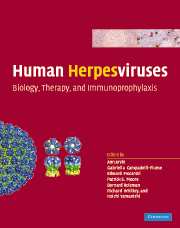Book contents
- Frontmatter
- Contents
- List of contributors
- Preface
- Part I Introduction: definition and classification of the human herpesviruses
- Part II Basic virology and viral gene effects on host cell functions: alphaherpesviruses
- Part II Basic virology and viral gene effects on host cell functions: betaherpesviruses
- Part II Basic virology and viral gene effects on host cell functions: gammaherpesviruses
- Part III Pathogenesis, clinical disease, host response, and epidemiology: HSV-1 and HSV-2
- Part III Pathogenesis, clinical disease, host response, and epidemiology: VZU
- Part III Pathogenesis, clinical disease, host response, and epidemiology: HCMV
- Part III Pathogenesis, clinical disease, host response, and epidemiology: HHV- 6A, 6B, and 7
- Part III Pathogenesis, clinical disease, host response, and epidemiology: gammaherpesviruses
- 50 Clinical and pathological aspects of EBV And KSHV infection
- 51 EBV: Immunobiology and host response
- 52 Immunobiology and host response to KSHV infection
- 53 The epidemiology of EBV and its association with malignant disease
- 54 The epidemiology of KSHV and its association with malignant disease
- 55 EBV-induced oncogenesis
- 56 KSHV-induced oncogenesis
- Part IV Non-human primate herpesviruses
- Part V Subversion of adaptive immunity
- Part VI Antiviral therapy
- Part VII Vaccines and immunothgerapy
- Part VIII Herpes as therapeutic agents
- Index
- Plate section
- References
53 - The epidemiology of EBV and its association with malignant disease
from Part III - Pathogenesis, clinical disease, host response, and epidemiology: gammaherpesviruses
Published online by Cambridge University Press: 24 December 2009
- Frontmatter
- Contents
- List of contributors
- Preface
- Part I Introduction: definition and classification of the human herpesviruses
- Part II Basic virology and viral gene effects on host cell functions: alphaherpesviruses
- Part II Basic virology and viral gene effects on host cell functions: betaherpesviruses
- Part II Basic virology and viral gene effects on host cell functions: gammaherpesviruses
- Part III Pathogenesis, clinical disease, host response, and epidemiology: HSV-1 and HSV-2
- Part III Pathogenesis, clinical disease, host response, and epidemiology: VZU
- Part III Pathogenesis, clinical disease, host response, and epidemiology: HCMV
- Part III Pathogenesis, clinical disease, host response, and epidemiology: HHV- 6A, 6B, and 7
- Part III Pathogenesis, clinical disease, host response, and epidemiology: gammaherpesviruses
- 50 Clinical and pathological aspects of EBV And KSHV infection
- 51 EBV: Immunobiology and host response
- 52 Immunobiology and host response to KSHV infection
- 53 The epidemiology of EBV and its association with malignant disease
- 54 The epidemiology of KSHV and its association with malignant disease
- 55 EBV-induced oncogenesis
- 56 KSHV-induced oncogenesis
- Part IV Non-human primate herpesviruses
- Part V Subversion of adaptive immunity
- Part VI Antiviral therapy
- Part VII Vaccines and immunothgerapy
- Part VIII Herpes as therapeutic agents
- Index
- Plate section
- References
Summary
EPSTEIN-BARR VIRUS EPIDEMIOLOGY
Epidemiology of primary Epstein-Barr virus infection
Epstein-Barr virus (EBV) is an ancient virus, and has probably coevolved with its different hosts over the last 90–100 million years (McGeoch et al., 1995). With the ability to establish lifelong latency and intermittent reactivation after primary infection and with limited clinical symptoms in the majority of infected individuals, EBV has become ubiquitous in all human populations
Age at primary infection
Children in developing countries acquire the infection in the first few years of life, and universal seroconversion is often seen by ages 3–4 years, whereas infection in developed countries often is delayed until adolescence (de The et al., 1975; Haahr et al., 2004; Henle and Henle, 1967; Melbye et al., 1984a,b) (Figure 53.1). In some developed countries a bimodal infection rate, with peaks in children below 5 years and again after 10 years of age, has been described (Edwards and Woodroof, 1979; Henle and Henle, 1967; Lai et al., 1975). Oral EBV excretion between parents and infants, and from intimate partners in adolescence and early adulthood is the likely explanation for the observed bimodality (Crawford et al., 2002; Fleisher et al., 1979).
EBV antibody titers in seropositive individuals vary according to age following a U-shaped pattern, with high titers among infants and in the elderly (above 50 years) (Glaser et al., 1985; Venkitaraman et al., 1985).
- Type
- Chapter
- Information
- Human HerpesvirusesBiology, Therapy, and Immunoprophylaxis, pp. 929 - 959Publisher: Cambridge University PressPrint publication year: 2007
References
- 55
- Cited by

